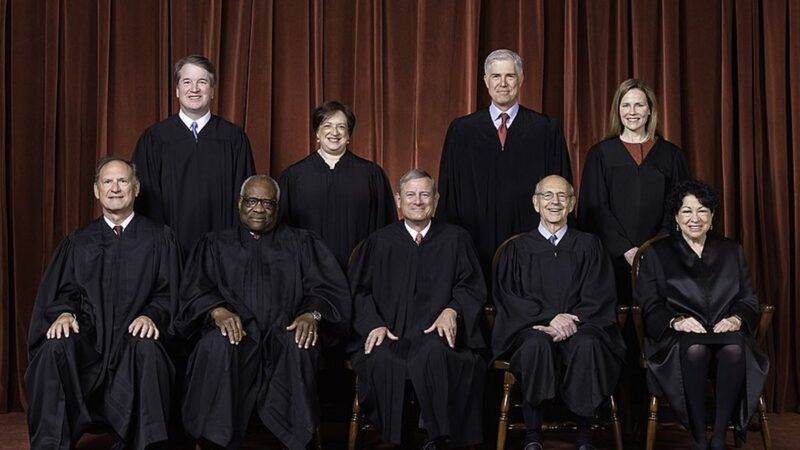Supreme Court Won't Make Ban on Non-Unanimous Jury Convictions Retroactive
Bad news for hundreds of imprisoned defendants in Louisiana and Oregon

The Supreme Court ruled 6–3 today that a previous decision—one forcing an end to non-unanimous jury verdicts in criminal trials—shall not be made retroactive.
Today's decision, in Edwards v. Vannoy, answered a question posed by 2020's ruling in Ramos v. Louisiana: If the Supreme Court decides that non-unanimous jury decisions are unconstitutional, do all of those convictions need to be tossed out and the cases retried? The defendant in this case, Thedrick Edwards, was convicted in 2007 of rape, armed robbery, and kidnapping. But two jurors voted to acquit. It was not a unanimous decision. Edwards asked and the Supreme Court agreed to consider whether the Ramos decision was retroactive.
Today, the Supreme Court majority ruled that it was not. Fundamentally this means that people convicted in Louisiana and Oregon, the only two states that have recently permitted non-unanimous convictions, can't turn to the federal government to request relief. (Louisiana citizens voted to end the practice in 2018.)
It's harsh. As the majority opinion, written by Justice Brett Kavanaugh, explains, the Supreme Court almost never makes its rulings on criminal justice issues retroactive to affect those who have already been sentenced. A 1989 precedent, set in Teague v. Lane, set up guidelines for when the Court would consider making a decision on criminal procedure retroactive. Since setting up that test, the Supreme Court has declined to make a single new criminal justice procedural rule retroactive.
The pivotal question the court considers in the Teague doctrine is whether a change counts as a "watershed" rule of criminal procedure. That means, first, that the rule must be necessary to prevent "an impermissibly large risk of an inaccurate conviction." And second, the rule must change the justice system's "understanding of the bedrock procedural elements essential to the fairness of a proceeding."
While one might reasonably conclude that requiring all jury convictions be unanimous would fit the above categories, the majority (all the conservative justices: Kavanaugh, Clarence Thomas, Neil Gorsuch, Samuel Alito, Amy Coney Barrett, and Chief Justice John Roberts) concluded it did not. And three of those justices—Kavanaugh, Thomas, and Gorsuch—agreed with the majority in Ramos. They think non-unanimous convictions were unconstitutional, but they also think those who were convicted by non-unanimous juries were not entitled to relief.
In today's decision, Kavanaugh lists many previous decisions in which Supreme Court justices declined to make their rulings retroactive. He also notes that Edwards' lawyers attempted to use some of those cases to argue for retroactivity. Because the courts never made those previous rulings retroactive, Kavanaugh concludes that it seems unlikely that any future court ruling ever will:
At this point, some 32 years after Teague, we think the only candid answer is that none can—that is, no new rules of criminal procedure can satisfy the watershed exception. We cannot responsibly continue to suggest otherwise to litigants and courts. In Teague itself, the Court recognized that the purported exception was unlikely to apply in practice, because it was "unlikely" that such watershed "components of basic due process have yet to emerge."
He calls the "watershed" exception an "empty promise" that presents a false hope to defendants in these cases. And then he makes it explicit: "New procedural rules do not apply retroactively on federal collateral review. The watershed exception is moribund."
Thomas and Gorsuch also each wrote separate concurrences (and signed onto each other's) endorsing the abandonment of the Teague test.
Dissenting from the majority were Justices Elena Kagan, Stephen Breyer, and Sonia Sotomayor. Kagan wrote the dissent, which is itself notable because Kagan broke from the other liberal justices in the original Ramos case. Kagan has a strong history of support for maintaining stare decisis, the principle that the Supreme Court should rarely overturn its past precedents. For that reason, she objected in 2020 to Ramos overturning a previous ruling that allowed for non-unanimous jury verdicts in state trials. She was in the minority in that ruling. Now she doesn't want to overturn the "watershed" component of the Teague doctrine, actually for similar reasons.
She argues that the Ramos decision was, indeed, a watershed ruling. Interestingly, Kagan explains the reason Ramos is a watershed ruling was because it did the very thing she objected to—it overturned what had previously been a settled Supreme Court question. She notes:
At bottom, then, the Court took the unusual step of overruling precedent for the most fundamental of reasons: the need to ensure, in keeping with the Nation's oldest traditions, fair and dependable adjudications of a defendant's guilt. In this much alone, Ramos's reasoning evokes this Court's descriptions of watershed rules.
She further objects to overturning Teague in a case where nobody argued that they should. And she notes the potential long-term consequences: Even though the Supreme Court has not in the past found a case to fit Teague's guidelines, that doesn't mean it should close off the possibility of it happening in the future.
"For the first time in many decades…those convicted under rules found not to produce fair and reliable verdicts will be left without recourse in federal courts," she writes.
In Oregon and Louisiana, lawyers for defendants convicted by non-unanimous juries are working to try to get post-conviction relief. In Louisiana, one group has filed more than 1,000 claims on behalf of people serving prison terms. In Oregon, hundreds are in prison hoping for retrials and Attorney General Ellen Rosenblum is under pressure to do something. She has resisted, hoping that today's decision will give her an answer. It did. We'll see how well that sits with her constituents.



Show Comments (26)